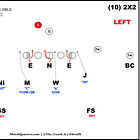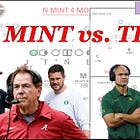Georgia's Four-Down Front
Everything starts and finishes up front in Athens. Meet Georgia, where the best talent meets the best scheme and gets coached.
With Nick Saban retired, Kirby Smart, Glenn Schumann, and the Georgia Bulldogs defense run the most advanced defense in college football. Dan Lanning and Tosh Lupoi of Oregon could argue about this, but the best defensive scheme lies in Athens, Georgia.
Georgia's defensive talent is the envy of the college world. Since the ‘21 draft, the Bulldogs have had five CBs, three Safeties, four LBs, five Edge/DEs, and three DTs in the NFL. That is a lot of talent in one spot. Athens has become an NFL factory in an already saturated SEC.
However, Georgia's largest collection of elite talent is located in the trenches. Smart has built a system that relies heavily on the defensive line winning their match-ups and creating massive amounts of pressure.
One of the system's main philosophies has been the ability to stop opponents' run games with as few defenders as possible. Georgia must have a superior defensive line in talent and technique to do this. It also needs to have answers.
Another talented defensive coordinator, Seattle Seahawks Head Coach Mike Macdonald, embodies this philosophy. His mantra in Baltimore and, surely, Seattle was, ‘Stop the run to have some fun.’ Defense is a math problem that needs to be solved, and every unit has only a finite number of players (eleven).
With Spread philosophies taking over all levels of football, the defense has to master stopping the run in multiple scenarios. But a defense cannot forget to defend the pass. The rise of the Spread and analytics in the past decade has made the passing game much more valuable and harder to defend.
Problems can be solved with coverage, but Georgia understands that on early downs, to allocate more numbers to the passing game, the standard seven, the defensive line must be able to penetrate and cause issues against five—to six-man protections or stagnate the run until support can arrive.
Georgia's defense generally mirrors the average FBS defense (above). However, in recent years, the Bulldogs have run more split-field than closed-post coverage, which can be attributed to a shift in internal philosophy and the rise of mobile quarterbacks. Split-field coverages allow the Bulldogs to hide intentions, leverage motion, and lean into their four-down base. But that wasn’t always the case.
Starting in 2014, Smart and Saban began to rethink their personnel and defensive systems after their Sugar Bowl loss to Ohio State. Over several years, Georgia and Alabama began running more ‘Bear’ or Tite Fronts to counter the advancement of Spread systems in the SEC and college as a whole.
The Bulldogs still do this today against larger offensive personnel like 12 and 21 packages. Their Base 3-4 is a Day 1 install and is even more important as NFL ideas trickle down to the college offenses. At the highest level of football, 12 pers. has become the new base offense, typically with a hybrid ‘flex’ TE and a secondary on-line traditional ‘Y.’ Shanahan-style offenses even feature a FB.
Post-2017, the Mint package became a standard way for Georgia to attack Spread offenses. During this time, we also saw an explosion in 3-High systems, namely Iowa State, to counter this trend. Offensively, college offenses had morphed into a standard zone-centric 11 pers. system that attacked space downfield in the passing game and ran mostly zone in the box.
RPOs and play-action on early downs took advantage of the space given up in the traditional 4-2-5 Quarters systems developed in the late 2000s. Teams like ‘Bama in the mid-10s had to quickly pivot away from lumbering 3-4s with ILBs built like Nose Guards. Smart detailed this in a 2018 coaches clinic. The offensive landscape had changed drastically, and Smart needed to pivot, and initially, Mint was the answer.
Keep reading with a 7-day free trial
Subscribe to MatchQuarters by Cody Alexander to keep reading this post and get 7 days of free access to the full post archives.








